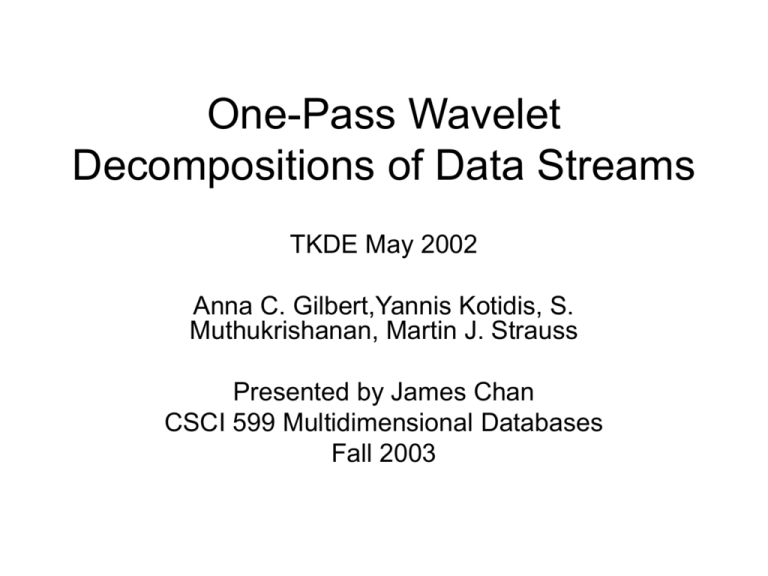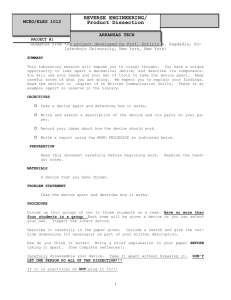Presentation
advertisement

One-Pass Wavelet
Decompositions of Data Streams
TKDE May 2002
Anna C. Gilbert,Yannis Kotidis, S.
Muthukrishanan, Martin J. Strauss
Presented by James Chan
CSCI 599 Multidimensional Databases
Fall 2003
Outline of Talk
•
•
•
•
•
Introduction
Background
Proposed Algorithm
Experiments
End Notes
Streaming Applications
•
•
•
•
•
Telephone Call Duration
Call Detail Record (CDR)
IP Traffic Flow
Bank ATM Transactions
Mission Critical Task:
– Fraud
– Security
– Performance Monitoring
Data Stream Model
Synopsis in Memory
Data Streams
Stream
Processing
Engine
(Approximate)
Answer
Data Stream Problem
• One Pass – no backtracking
• Unbounded Data – Algorithms require small memory usage
• Continuous – Need to run real time
Data Stream Strategies
• Many stream algorithms produce
approximate answers and have:
– Deterministic Bounds: answers are within ±
– Probabilistic Bounds: answers have high
success probability (1-) within ±
Data Stream Strategies
• Windows: New elements expire after time t
• Samples: Approximate entire domain with a sample
• Histograms: Partitioning element domain values into
buckets (Equi-depth, V-Opt)
• Wavelets: Haar, Construction and maintenance (difficult
for large domain)
• Sketch Techniques: estimate of L2 norm of a signal
Proposed Stream Model
Background: Cash Register vs. Aggregate
• Cash Register: incoming stream represents
domain (increment or decrement range of that
domain)
• Aggregate: incoming stream represents range,
(update range of that domain)
Note: Examples in this paper assume
– each cash register element as +1 unit
– no duplicate elements in aggregate models
Background: Cash Register vs. Aggregate
Cash Register
(domain)
Aggregate
(range)
Easiest
Eg. Time Series
Ordered
Unordered
General Challenging
Eg. Network volume
Contiguous
Same as aggregate
unordered
n/a
Background: Wavelet Basics
• Wavelet transforms capture trends in a
signal
• Typical transform involves log n passes
• Each pass creates two sets of n/2
averages and differences.
• Process repeated on averages
• Output: Wavelet Basis vectors – one
average and n-1 coefficients
Background: Haar Wavelet Notation
•
High pass filter
{1 / 2 ,1 / 2}
•
Low pass filter
{1 / 2 ,1 / 2}
•
Input: signal a
[a1 , a2 ,...an ]
•
Basis Coefficients
[ w0 , w1 ,...wn 1 ] {c0, 0 } {d j , k }
•
Coefficients
d j ,k s j a, j ,k
•
Scaling Factor
sj N / 2j
•
Psi Vectors
(un-normalized)
j,k
j 3,k 0 [1,1,0,0,0,0,0,0]
j 3,k 2 [0,0,1,1,0,0,0,0]
j 2,k 0 [1,1,1,1,0,0,0,0]
Background: Haar Wavelet Example
Background: Small B Representation
• Most signals in nature
have small B
representation
• Only keep largest B
wavelet coefficients to
estimate energy of
signal
• Additional coefficients
do not help reduce
squared sum error
2
Energy:
R
SSE:
aR
2
2
2
Background: Storage
• Highest B wavelet
coefficients
• Log N Straddling
coefficients, one per
level of the wavelet
tree
+
2
2.75
+
-1.25
+
0.5
+
0
2
+
0
-
-
+
-1
-1
- +
2
3
Original Signal
0
0
- +
5
4
4
Background: Bounding Theorems
Theorem 1
• Given O(B+logN) storage (B is number of dimensions)
• time to compute new data item is O(B+logN) in ordered
aggregate model
Theorem 2
• Any algorithm that calculates the 2nd largest wavelet coefficient of
the signal in unordered CR / unordered agg uses at least
N/polylog(N)
• This holds if:
– You only care about existence, not the coefficients value
– Only calculating up to a factor of 2
Proposed Algorithm: Overview
• Avoid keeping anything domain size N in
memory
• Estimate wavelet coefficients using
sketches which are size log(N)
• Sketch is maintained in memory and is
updated as data entries stream in
What’s a Sketch?
•
•
•
•
•
•
•
•
Distortion Parameter
Failure Probability
Failure Threshold
Original Signal
Random vector of {-1,+1}s
Seed for r
Atomic Sketch
Sketch
(epsilon)
(delta)
(eta)
a
r
s
<a,r> dot product of a and r
O(log(N/ )/ ^2) atomic sketches
• We use the same j to index the atomic sketch, seed, and random
vector, so there are j atomic sketches in a sketch
Updating a Sketch
• Cash Register
j
r
– Add corresponding i to the j atomic sketches
• Aggregate
– Add corresponding a (i ) ri j to the j atomic sketches
j
s
Use generator that takes in seed i which is log(N) to
j
r
compute i
ri j G(s j , i)
Reed Muller Generator
• Pseudo random generator
meeting these requirements:
– Variables are 4 wise
independent
• Expected value of product of
any 4 distinct r is 0
– Requires O(log N) space for
seeding
– Performs computation in
polylog(N) time
{0} {d} {c} ….
{d,c,b,a}
Estimation of Inner Product
O(log(1/))
X = median (
O(log(1/^2))
)
…
= mean (
)
Boosting Accuracy and Confidence
• Improve accuracy to by averaging over more
a r b r
independent copies of for each
average
j
j
i i
i i
…
O(log(1/^2)) copies of
= means (
…
)
• Improve Confidence by increasing number of
averages to take median over
…
O(log(1/)) copies of
X = median of (
…
)
Using the sketches
j
j
a, b ~ ai ri bi ri
a, r b, r
j
j
Atomic Sketches
in memory
• We can approximate <a,> to maintain Bs
• Note a point query is <a,ei> where e is a vector
with a 1 at index i and 0s everywhere else
Maintaining Top B Coefficients
• At most Log N +1
coefficient updates
• May need to approximate
straddling coefficients to
aggregate with already
existing or near variables
• Compare updates with
top B and update top B if
necessary
ai
updated
unaffected
Algorithm Space and Time
Their algorithm uses polylog(N) space and per item
time to maintain B terms (by approximation)
Experiments
• Data: one week of AT&T call detail (unordered cash
register model)
• Modes
– Batch: Query only between intervals
– Online: Query anytime
• Direct Point: calc sketch of <ei,a> (ei is zero vector
except with 1 at i)
• Direct Wavelets: estimate all supporting coefficients and
use wavelet reconstruction to calculate point a(i)
• Top B: Reconstruction of point is done with Top B
(maintained by sketch)
Top B – Day 0
Top B - 1 Week
(fixed-set) Value
updates only. no
replacement
Sketch Size on Accuracy
Heavy Hitters
• Points that contribute significantly to the energy
of the signal
• Direct point estimates are very accurate for
heavy hitters but gross estimates for non heavy
hitters
• Adaptive Greedy pursuit: by removing the first
heavy hitter from the signal, you improve the
accuracy of calculating the next biggest heavy
hitter
• However an error is introduced with each
subtraction of a heavy hitter
Processing Heavy Hitters
Adaptive Greedy Pursuit
End Notes
• First Provable Guarantees for haar wavelet over
data streams
• Can estimate Haar coefficients ci=<a,>
3
• Top B is updated in: O(log N log( N ) B ( ))
• This paper is superseded by "Fast, Small-space
algorithms for approximate
histogram maintenance" STOC 2002
– Discusses how to select top B and find heavy hitters





